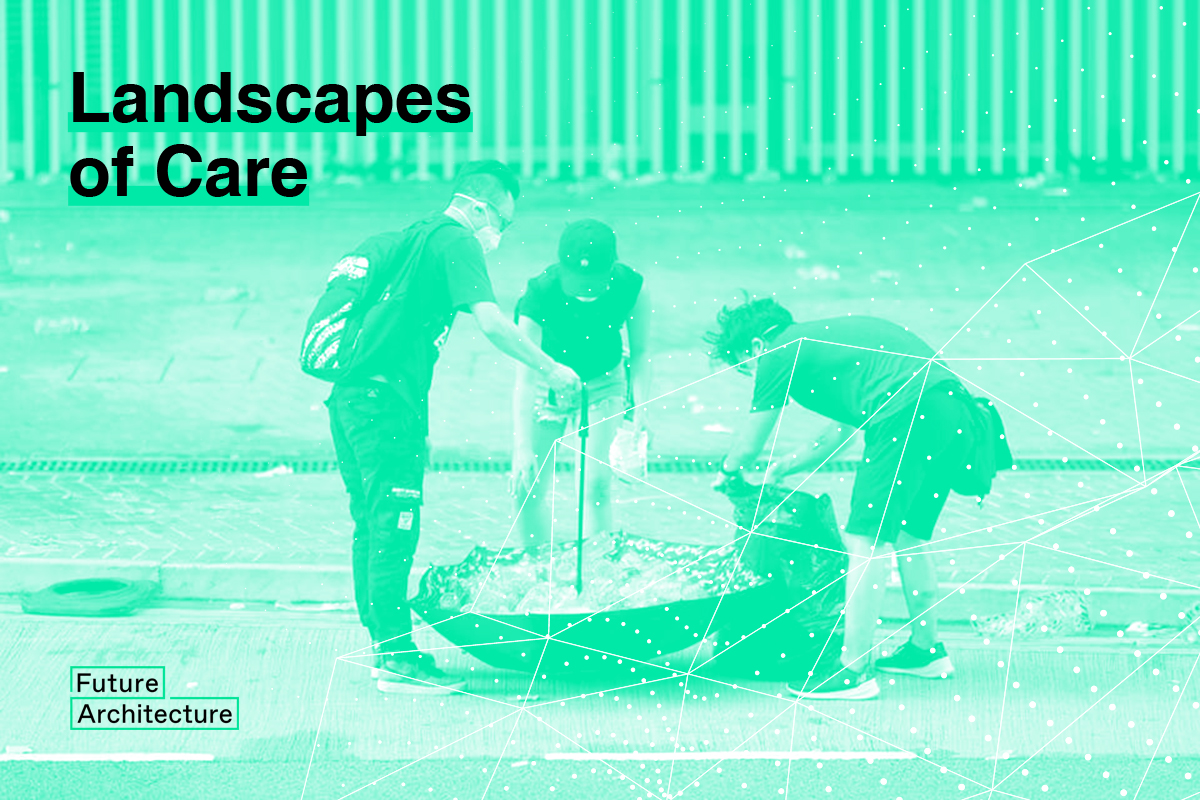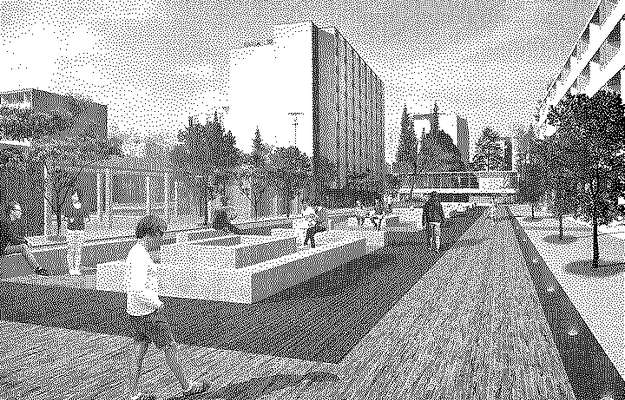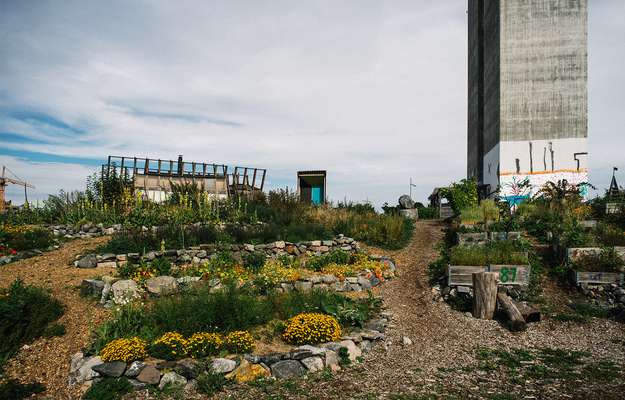What care has to do with it?
Designers, architects and urban planners are increasingly taking on the task of managing social and political issues of relationships, neighborhoods, energy flows, mobility, cultural heritage, identity and urban change, rather than just spatial and formal aspects. The theme ‘Landscapes of care’ focuses on a change of direction in the values, interests and priorities that drive architecture and urban planning. The main focus changes from the individual actor or the individual object, towards a greater sensitivity to issues of interconnection, attachment and interdependence.

During the lockdowns, due to the pandemics, there is a sector of activities that prove essential to keep our cities supplied and running, even at a slow pace. Those so called care-jobs are mostly carried out by what the system tends to classify as low-skilled workers. This necessarily leads us to two basic ideas: firstly the system of work values need revision, and secondly the notion of care is essential, being or not in crisis. In fact, in the midst of COVID-19, #Metoo, Black Lives Matter, biodiversity crisis, dramatic climate changes, and economic pressure on the welfare state the issues of care, empathy and sustainability seem to be more pressing. This applies not least in architecture and urban planning, which create and somehow regulate the spaces in which we live together and which must provide citizens with a safe environment and public spaces where they can unfold freely. At the same time, architecture and urban planning paradoxically constitute one of the greatest CO2 offenders, which has historically supported and maintained patriarchal, class, and colonial power structures, and which has yielded great economic returns. In short, the ways we build, live and consume have implications and emphasize our interconnectedness in a globalized age. And when bodies prove vulnerable, environments become overloaded, species become extinct and resources that have previously borne growth run out, we are reminded of our interdependence, vulnerability and mortality. Following the formulation of the Swedish philosopher Martin Hägglund: "Because everything we do and everything we love can come to an end, we are bound to care (curare) and be concerned."[1]
This motivates us to examine how care, empathy and sustainability are practiced - or not practiced - in architecture and urban planning today and historically. In light of current challenges, can we consider architecture and design as essential practices? If so, how can architecture and urban planning thus contribute to strengthening coexistence, solidarity, diversity and caring for each other, our planet and common resources in a time marked by pandemics, terrorism, migration, climate crisis, rising inequality, etc.? How does the design, management and maintenance of houses and urban spaces contribute to the formation of communities and behaviors in the public space? What happens when borders are closed and mobility is curtailed while we are globally challenged by pandemics as a common threat and we locally need more space to keep a safe distance? How is the balance between outside and domestic space on several levels shifted from the emergence of homeworking during the closure due to the state of emergency? How can we create inclusive and healthy urban spaces? What can we learn from the historical examples?
Designers, architects and urban planners are increasingly taking on the task of managing social and political issues of relationships, neighborhoods, energy flows, mobility, cultural heritage, identity and urban change, rather than just spatial and formal aspects. The theme ‘Landscapes of care’ focuses on a change of direction in the values, interests and priorities that drive architecture and urban planning. The main focus changes from the individual actor or the individual object, towards a greater sensitivity to issues of interconnection, attachment and interdependence.
In 2021 Future Architecture platform members, creatives and activities will focus on how care concretely manifests itself in architecture and urban development in a contemporary, historical and future perspective. We’ll seek for prototypes and systems, site-specific cases, and new alliances that put in evidence the care dimension of our practices:
Health and architecture
2020 was an annus horribilis that turned our everyday lives, homes and movements in the city space upside down. Together, the citizens had to quickly find ways to reorganize; the home was to accommodate the workplace, school, leisure activities, privacy, and many basic activities thus new norms of behavior in the public space were continuously developed, tested and implemented. Top-down initiatives during the closure have, for better or worse, highlighted the importance of the built environment for our individual well-being and societal organization, but have also raised awareness on the interventionist capacity of the states in limiting freedom of movement and citizen action. The fundamental relationship between hygiene and public health on the one hand and architecture and urban planning on the other has gained new relevance, but is far from new as a marker for our urban development. What’s the impact of the COVID-19 pandemic on how we think about architecture and urban planning, while drawing historical lines to the imprint of previous health crises on our built environment?
Diversity, equity and community
Questions about how we live well together peacefully in diversity and with respect for each other's differences are pressing on in several contexts. Inequality manifests in physical spaces as it’s not the same to be locked down in minimum space housing than in open residential spaces. In the same line, at urban scale in vulnerable public housing areas residents must vacate their communal areas on the basis of criteria to which privately owned residential areas and their residents are not subjected. Other examples are the existing zoning ban for homeless and other marginalized street residents, proposed zoning bans for ‘insecurity-creating’ stays in public spaces linked to gender and ethnicity, the design and regulation of camps for refugees and asylum seekers, etc. The community and its spatial expression have been put up for debate these years. Can architecture and urban development contribute concretely to facilitate safe mobility and equality in urban space? How can architecture and urban planning support people in precarious life situations and provide space for minorities? How do we take care of creating a safe, open city and inclusive public spaces at a time when many (new voices) express that they feel underrepresented and discriminated against every day, e.g. in the institutions' structures, public spaces and discourses about affiliation, homes, norms of behavior and policies?
Architecture as a climatic care provider?
Architecture and urbanism are responsible for some of the worst carbon monoxide emissions. Cement alone, one of the most widely used materials in construction nowadays, is the source of about 8% of the world's carbon dioxide (CO2) emissions[2]. How much care do urban planners, architects and landscape architects take to plan for future generations? How does the profession and decision makers show responsibility for achieving the goal of CO2-neutral cities? How do we, as homo sapiens, a species that significantly affects world evolution, take into account the other species with which we share the planet? In the so-called Anthropocene age, the common resources must be understood as elements that do not only belong to humans, therefore we might challenge familiar notions of species hierarchies. Although many conservation initiatives come for Western countries claiming to support biodiversity and nature conservation, the very nature of capitalism keeps us being the main resource consumers worldwide.
However, the COVID-19 pandemic has has boostered or provoked new initiatives: In December 2019 the EU has launched a European Green Deal with the goal of making Europa climate neutral by 2050[3]. At the same time, a new report from the C40 network of major cities around the world shows that green investment linked to post-pandemic reconstruction of societies can create significant economic, social and environmental gains[4]. Yet only 3-5% of global funds are earmarked for sustainable investment. How can we turn the tide? How does consideration for the well-being of our common resources affect the role of the architect and the ethics of the architectural profession? How do the management of our common resources such as clean air, drinking water and land affect urban development? How can architecture and planning help take care of the existing and renovate or nurture it, the landscapes, species, etc. that are threatened with destruction or extinction?
The Peripheral Pioneers and Utopia
Many smaller towns, islands and rural areas have for decades experienced evictions following the closure of jobs, educational institutions and the decay of the building stock. The concept of ‘outlying territories has become mainstream. But in an increasingly complex and climate-apocalyptic world, more and more people are dreaming of living the good, simple and literally nourishing life in the countryside. Both in relation to being able to live more sustainably and be more in harmony with nature, be part of local communities, experience less stress and as a (re) discovery of the qualities in the countryside beyond an economic growth ideology. Many choose to do it together and several new self-sufficient housing communities are formed. With the COVID-19 pandemic, this trend seems to have gained further traction, and even more city dwellers are moving to the countryside. As Rem Koolhaas prophetically stated with his exhibition, “Countryside, The Future”, which opened just before the global closure of cities: "The countryside is where the radical changes are." What notions of and experiments for settlement and community do we see emerge, and what visions and concrete methods are they built on? What experiences about sustainability can be drawn from the new 'utopias' in the countryside and into urban planning? That the future is urban has been established for a long time, but what if it is also time to look at the rural in our search for sustainable coexistence between humans, species and ecosystems?
[1] Martin Hägglund. “This Life. Secular Faith and Spiritual Freedom". Pantheon Books, New York 2019.
[2] Chatham House Report. Making Concrete Change: Innovation in Low-carbon Cement and Concrete. 13 June 2018. ISBN: 978 1 78413 272 9
[3] A European Green Deal. Striving to be the first climate-neutral continent https://ec.europa.eu/info/strategy/priorities-2019-2024/european-green-deal_en
[4] C40 Cities Climate Leadership Group. Cities, Coronavirus (COVID-19) and a Green Recovery
***
Image credits: Demonstrators spontaneously took to the scene to clean up the rubbish.
Photo by 朱韵和
@zhu0588 https://twitter.com/zhu0588/status/1158968070007709696


